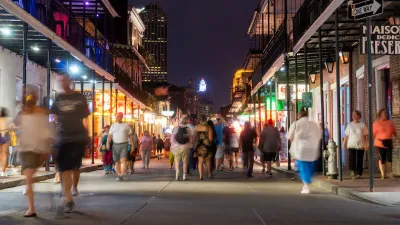Two-thirds of people who leave prison go back within three years, and many who leave prison go back to particular urban neighborhoods. New Orleans want to spend more smartly in areas whose community life is disrupted by such a cycle.
"Hurricane Katrina displaced hundreds of thousands of New Orleans residents; as they've returned, their struggles to remake their lives and communities have been well chronicled. But smaller waves of displacement, followed by straggling return, have been washing through the city, largely unremarked, for many years. In 2003, upwards of 12,000 New Orleans–area residents left the city for prison; more than half were expected to return home within three years. This destructive cycle, interrupted by the storm, is slowly reasserting itself.
Nationwide, an estimated two-thirds of the people who leave prison are rearrested within three years. A disproportionate number of them come from a few urban neighborhoods in big cities. Many states spend more than $1 million a year to incarcerate the residents of single blocks or small neighborhoods.
One such 'million-dollar neighborhood' is shown-a half-square-mile portion of Central City, an impoverished district southwest of the French Quarter. In 2007, 55 people from this neighborhood entered prison; the cost of their incarceration will likely reach about $2 million."
FULL STORY: Prison Blocks

Alabama: Trump Terminates Settlements for Black Communities Harmed By Raw Sewage
Trump deemed the landmark civil rights agreement “illegal DEI and environmental justice policy.”

Planetizen Federal Action Tracker
A weekly monitor of how Trump’s orders and actions are impacting planners and planning in America.

The 120 Year Old Tiny Home Villages That Sheltered San Francisco’s Earthquake Refugees
More than a century ago, San Francisco mobilized to house thousands of residents displaced by the 1906 earthquake. Could their strategy offer a model for the present?

Indy Neighborhood Group Builds Temporary Multi-Use Path
Community members, aided in part by funding from the city, repurposed a vehicle lane to create a protected bike and pedestrian path for the summer season.

Congestion Pricing Drops Holland Tunnel Delays by 65 Percent
New York City’s contentious tolling program has yielded improved traffic and roughly $100 million in revenue for the MTA.

In Both Crashes and Crime, Public Transportation is Far Safer than Driving
Contrary to popular assumptions, public transportation has far lower crash and crime rates than automobile travel. For safer communities, improve and encourage transit travel.
Urban Design for Planners 1: Software Tools
This six-course series explores essential urban design concepts using open source software and equips planners with the tools they need to participate fully in the urban design process.
Planning for Universal Design
Learn the tools for implementing Universal Design in planning regulations.
Clanton & Associates, Inc.
Jessamine County Fiscal Court
Institute for Housing and Urban Development Studies (IHS)
City of Grandview
Harvard GSD Executive Education
Toledo-Lucas County Plan Commissions
Salt Lake City
NYU Wagner Graduate School of Public Service





























